Foundation for Rural & Regional Renewal (FRRR)
Nearly $280,000 supports 16 initiatives across Australia
FRRR has awarded $278,693 in grants for projects that will help remote, rural and regional communities decarbonise, adapt to a changing climate, and mitigate the risks of global warming.
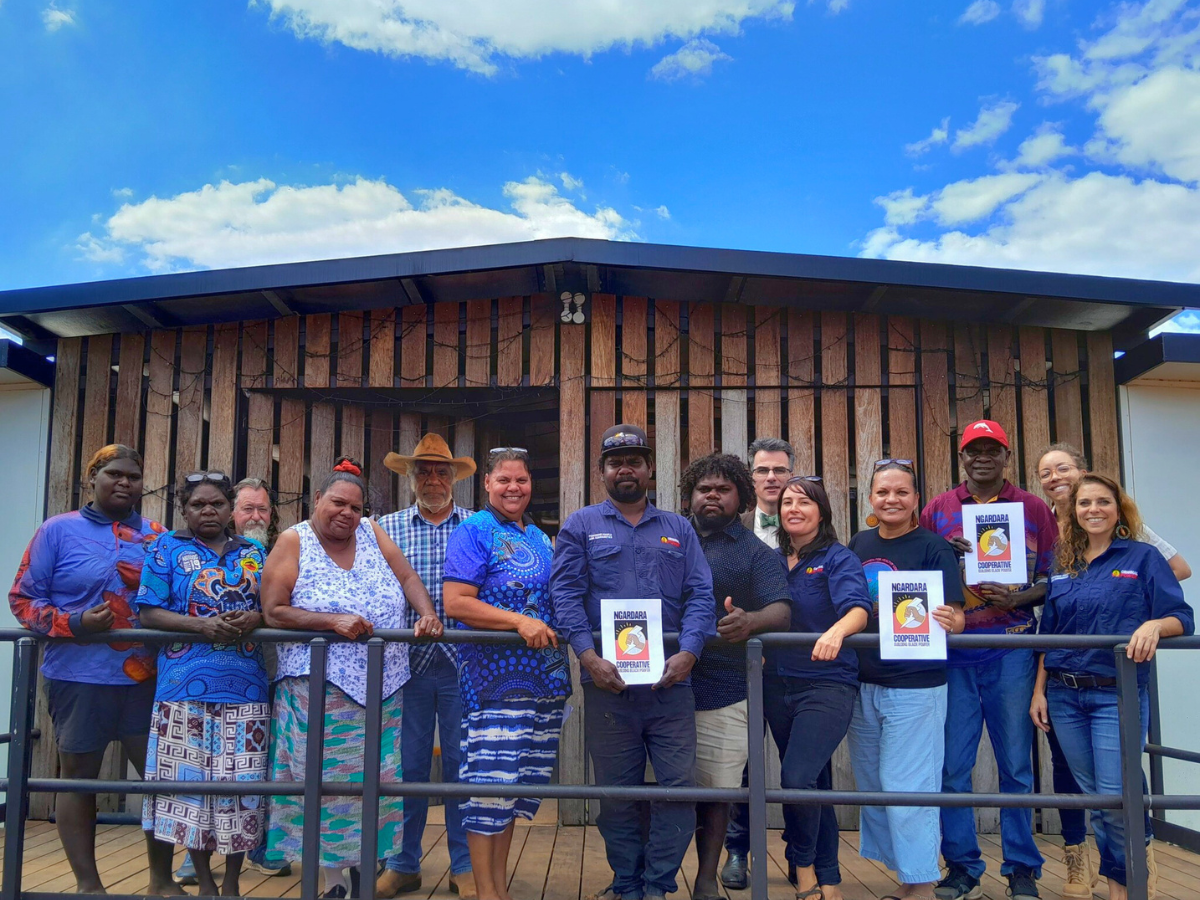
The 16 community-driven projects are the first through FRRR’s Community Led Climate Solutions program, thanks to support from Boundless Earth and Hand Heart Pocket.
Grants include $14,957 to support regenerative farming practice for soil health and emissions reductions in Macleay, NSW; $20,000 to build energy efficiency for social housing in Gympie, QLD; $20,000 to provide information and links to employment pathways through pop-up events in Gippsland, VIC; and $20,000 to enable a local Indigenous community in NT to build their capacity in order to establish their own solar microgrid and reduce reliance on diesel-powered electricity.
Sarah Matthee, FRRR’s General Manager – Partnerships & Services, said that the applications reflected the diversity of community organisations in Australia, the variety of climate solutions underway across rural communities, and the breadth of opportunities available to enable local groups to take action.
“The requests we received reinforce the fact that these communities are being impacted socially, economically and environmentally by increasing temperatures and extreme weather events. These communities are aware and concerned about the impacts of a changing climate, and these projects demonstrate their ambition to engage locals in conversations about their region’s future, and lead their community in taking action to reduce emissions.
“People living in remote, rural and regional communities have the knowledge and ideas to implement solutions that can help to decarbonise, mitigate climate risks, and adapt in a changed climate environment. But they need a hand to take action.
“With the support of Boundless Earth and Hand Heart Pocket, we’ve been able to fund 16 place-based, community-led climate solutions projects, which we hope will influence and deliver change for social, environmental and economic community benefit across remote, rural and regional Australia,” Ms Matthee said.
Organisations awarded Community Led Climate Solutions grants, and their funded projects, include:
- Original Power Ltd with Ngardara Cooperative Ltd – Borroloola, NT – Support a local, Indigenous community to establish their own solar microgrid, providing them with a sustainable energy source and reducing their reliance on diesel-powered electricity – $20,000
- Surfers for Climate – Byron Bay, NSW – Engage and educate tradespeople who surf in sustainable and circular building practices through local workshops in coastal NSW – $20,000
- Environmental Advocacy in Central Queensland Inc – Yeppoon, QLD – Drive education and engagement on climate change and the transition to renewable energy sources in Central Queensland by screening a documentary and presenting an experienced panel including local and national representation – $3,905
- Cire Services Incorporated – Yarra Junction, VIC – Promote circularity practice with reuse and repurpose workshops that will reduce landfill and develop skills that enable sustainable practices – $20,000
FRRR and its donor partners are committed to funding community-led solutions that reduce emissions and address the impacts of climate change. Community-led solutions help drive positive and sustainable environmental, social and economic outcomes for remote, rural and regional Australia. FRRR welcomes further contributions to this collaborative pool of funds to grow the impact that can be generated across remote, rural and regional Australia. For more information, please visit https://frrr.org.au/giving/.
The full list of grant recipients and their projects are below.
| Organisation | Project | Location | Grant | |||
|---|---|---|---|---|---|---|
| NEW SOUTH WALES | ||||||
| Container of Dreams Ltd | Container of Dreams Battery Storage and Charging Station Build community capacity to reduce emissions through a communal solar battery charging station to decrease reliance on fossil fuel generators. | Drake | $20,000 | |||
| Macleay Landcare Network Inc | Regenerative Farming Soils in the Macleay Project Build organisational capacity to engage and support landowners’ adoption of regenerative agriculture practice through workshops and volunteer training. | Kempsey | $14,957 | |||
| Surfers for Climate | The Trade Up by Surfers for Climate Engage and educate tradespeople who surf in sustainable and circular building practices through local workshops in coastal NSW. | Byron Bay | $20,000 | |||
| NORTHERN TERRITORY | ||||||
| Original Power Ltd on behalf of Ngardara Cooperative Ltd | Ngardara Community Solar Microgrid - Community Clean Energy and Climate Solutions Capacity Development Support a local, Indigenous community to establish their own solar microgrid, providing them with a sustainable energy source and reducing their reliance on diesel-powered electricity. | Borroloola | $20,000 | |||
| QUEENSLAND | ||||||
| 350.Org Ltd | Power Up Masig Develop the community engagement and prefeasibility model for a just transition to community-owned renewable energy supply in Torres Strait Island, Masig. | Masig Island | $20,000 | |||
| Bundaberg Fruit and Vegetable Growers Ltd | Water Wise Gardens - Revolutionising School Landscapes With Low Water Solutions Build capability in schools vulnerable to climate change impacts on water to sustain gardens that can scaffold community food systems and enable this learning through school curriculum development and training. | Gympie | $19,786 | |||
| Community Action Inc on behalf of Gympie and District Sustainability Alliance | Community Action Inc Building Energy Efficiency Project (CAI Beep) Support clean energy transition for social housing and community organisation tenants to enable cost efficiency and promote solar and battery systems to other providers. | Gympie | $20,000 | |||
| Community Enterprise Queensland | Arkai (Kubin) Community Garden Activate locally led opportunities to advance Moa Island Community sustainability and resilience to climate change with a community garden cultivating produce. | Moa Island | $18,525 | |||
| Environmental Advocacy in Central Queensland Inc | Climate Changers Screening and Discussion Panel Drive education and engagement on climate change and the transition to renewable energy sources in Central Queensland by screening a documentary and presenting an experienced panel including local and national representation. | Yeppoon | $3,905 | |||
| Mount Morgan Citizen's Club Inc | Leading the Way - Solar Power for the Soldiers' Rooms Enhance community organisation operations with solar panels that are a catalyst for activating local education and engagement on climate solutions to reduce emissions and benefit community. | Mount Morgan | $18,000 | |||
| The Trustee for Abriculture Advancement Trust | Roots of Sustainability: Cultivating Indigenous Leadership through Aquaponics and Permaculture Develop capability in regenerative farming and aquaponics in Indigenous agriculture for food systems adapting to climate change. | Cairns | $20,000 | |||
| VICTORIA | ||||||
| Cire Services Inc | Crafting Environmental and Social Benefits Through Cire FICE's Upcycling / Eco Fashion Workshops Promote circularity practice with reuse and repurpose workshops that will reduce landfill and develop skills that enable sustainable practices. | Yarra Junction | $20,000 | |||
| Gippsland Climate Change Network Inc | Gippsland New Energy 'PowerPops' Educate and engage community members in the Latrobe Valley on the transition to renewable energy to support informed decision making and awareness of employment and skills training opportunities. | Traralgon | $20,000 | |||
| Kiewa Catchment Landcare Groups Inc | Exploring Electric Vehicles with Kiewa Catchment Landcare and Kilowatt Cars Educate the Kiewa Valley community on the benefits of electric vehicle (EV) transportation and encourage their transition to owning an EV, and actively participating in reducing greenhouse gas emissions. | Mount Beauty | $7,460 | |||
| Parklands Albury Wodonga Ltd | Restoring Bonegilla's Blue Carbon Sink Wetlands and Waterways Restore ecosystem through seed propagation, revegetation and habitat restoration with educational community plantings advised by local Indigenous caretakers. | Bonegilla | $16,060 | |||
| The Gippsland Field Days on behalf of GreenLabs | Lardner Park Waste to Energy Pilot Project Develop and pilot a biohub for food organics and garden organics diversion to produce bioenergy which can reduce emissions and develop circular economy practice in Gippsland. | Lardner | $20,000 | |||
Grants up to $20,000 available for community-led initiatives
Remote, rural and regional not-for-profit organisations (NFPs) seeking to implement practices and solutions that reduce the impact of the changing climate can now apply for grants up to $20,000 through FRRR’s new Community Led Climate Solutions program (CLCS).
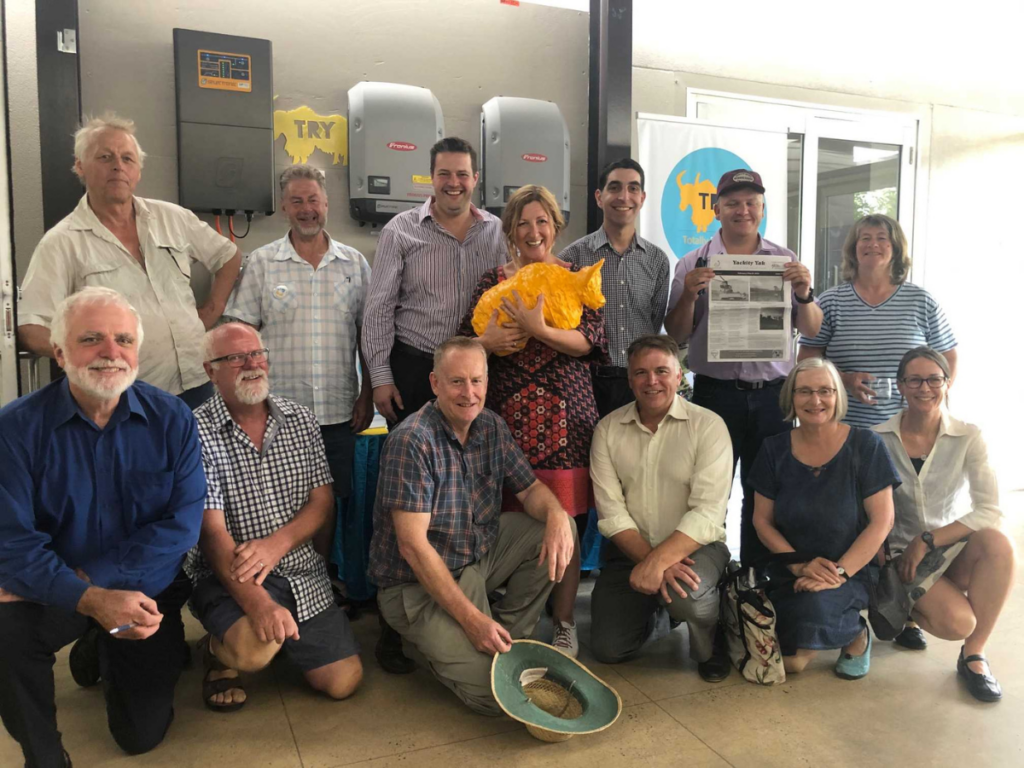
The grants can fund community-driven projects that educate and engage local people to reduce emissions, adopt clean energy practices, low carbon power sources, and embrace reuse and regenerative practices. Funding can also support solutions that deliver sustainable agriculture and food systems, biodiverse ecosystems, or activities designed to maintain the livelihoods of people reliant on industries in transition.
Sarah Matthee, General Manager, Partnerships & Services at FRRR, said many rural communities are eager to capitalise on cleaner and more sustainable climate solutions but often have limited access to funding or simply don’t have the capacity to investigate options.
“By offering flexible funding that is focused on community-led climate solutions, we want to enable NFPs to develop local solutions that respond to and mitigate the impacts of a changing climate in a way that is meaningful and responsive to the needs their community.
“Thanks to generous seed funding from Boundless Earth and Hand Heart Pocket, there is more than $300,000 available across the coming rounds of the Community Led Climate Solutions program. Our donor partners are committed to funding community-led solutions that reduce emissions and address the impacts of climate change and we are pleased to be working with them to fund local initiatives that will help drive positive and sustainable environmental, social and economic outcomes for rural Australia. We welcome further contributions to this collaborative pool to grow the impact that can be generated across rural Australia.
“In terms of examples of what the program can fund, there are several initiatives that FRRR has previously supported, which we think could inspire other communities. For example, Augusta Margaret River Clean Community Energy Incorporated received funding to undertake a dairy waste energy study, ahead of planning for an aggregated biogas and renewable power grid-connected facility. We’ve also funded free informative workshops on energy efficiency and renewable energy in small Victorian towns.
“You may have had a climate solutions project in mind for a long time but haven’t known where to go for support. We encourage people to think outside the box, reflecting on what your community needs most, to address and mitigate the impacts of climate change,” Ms Matthee said.
Applications for the Community Led Climate Solutions program close Thursday, 30 November 2023 at 5 pm AEDT. More information can be found at frrr.org.au/community-led-climate-solutions/.
By Nina O’Brien, Disaster Resilience and Recovery Lead
The call to action at this year’s Australian Disaster Resilience Conference is deeply apparent and has been reflected in most of the presentations, including my own – we must expand our understanding, balance investment, and elevate the voice of community, particularly First Nations people, to reduce the risks and impacts of a changing climate, and build collective resilience towards the increasing severity and frequency of disasters.
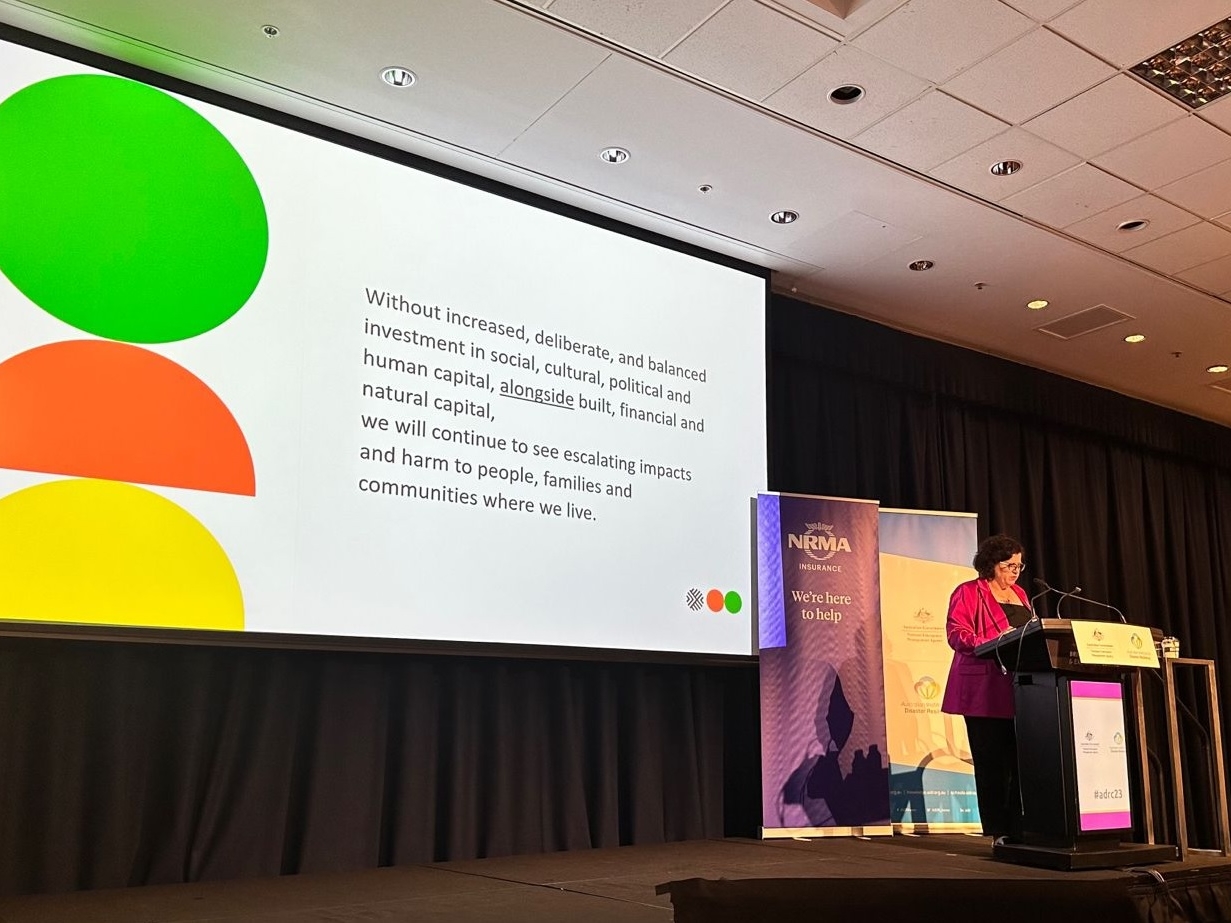
At FRRR, we are addressing this call to action by working deeply with local groups that are on the ground, working to enhance the preparedness and resilience of their remote, rural and regional communities. Programs like Disaster Resilient: Future Ready, as well as the thousands of grassroots, community-based projects we support through small grants like SRC Prepare and Recover , and others such as Rebuilding Futures, allow us to learn from local leaders about the needs and priorities of their communities, and how we can best support them to build local resilience and disaster recovery.
My presentation spoke of the importance of balanced investment in people and processes, not just products and ‘things’ across the entire disaster cycle, with a specific focus on preparedness. Social, cultural, political, and human capital are equally as vital as built, financial and natural capital in bolstering resilience. This approach takes a holistic view that acknowledges the interconnectedness of all these facets of community life.
This is why I advocate that we must shift our focus from (often) the disproportionate investing in products and things (hard infrastructure, as we often refer to it) to prioritising people and processes (or the soft infrastructure).
Ultimately, it is the people and processes that really make communities tick and make a difference in effective disaster response, recovery, and preparedness.
This is reinforced by the findings of ongoing research that FRRR has commissioned alongside our learning partner, University of Sydney.
“Working in a community led way to build local resilience means that local community members act as equal decision makers with a range of other stakeholders (local government, emergency services, service providers, business) to address issues which are priorities for that community. Rather than a top-down approach, where decisions are made outside a community or are made by government or other formal authorities, community led resilience building starts and continues with listening and collaborating on the priorities of community members. Genuine ownership by the local community requires their active involvement in all aspects of resilience building, not merely consultation.”
Howard, A., Rawsthorne, M. and Joseph, P. (2022) Critical Dimensions in Community Disaster Resilience [FactSheet], University of Sydney for the Foundation for Rural & Regional Renewal
The formal study has reinforced our anecdotal observations that when communities take the lead in driving resilience-building efforts, remarkable things happen. Whether tackling natural disasters like cyclones, bushfires, floods, or adapting to community shocks such as the loss of major services or industries, community-led initiatives tend to persist longer and have ongoing positive impacts. They foster local strengths that can adapt to a wide range of challenges over time.
This work provides an important formal evidence base for supporting grassroots not-for-profit organisations that are critical to nurturing the vitality of regional communities.
It also validates FRRR’s preferred approach of working alongside communities, mapping their assets and systems of interconnectivity, understanding their particular strengths and nuances, and viewing community life through resilience dimensions that help to identify and craft locally driven resilience initiatives.
Through diverse funding mechanisms that prioritise people and processes, we’ve seen tangible dividends in increased resilience. These include support for locally conceived projects and initiatives; building volunteer capacity and strengthening networks; resilience coaching, mentoring and support; strengthening internal organisational capacity; and fostering long-term project delivery capability through sustainable local partnerships.
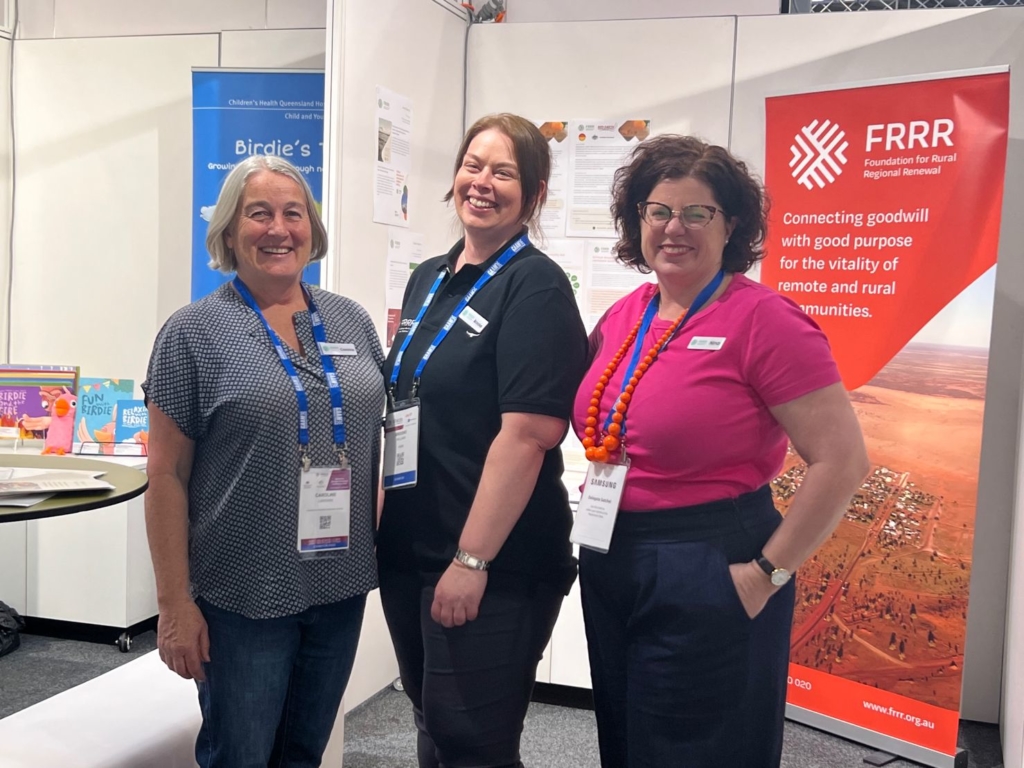
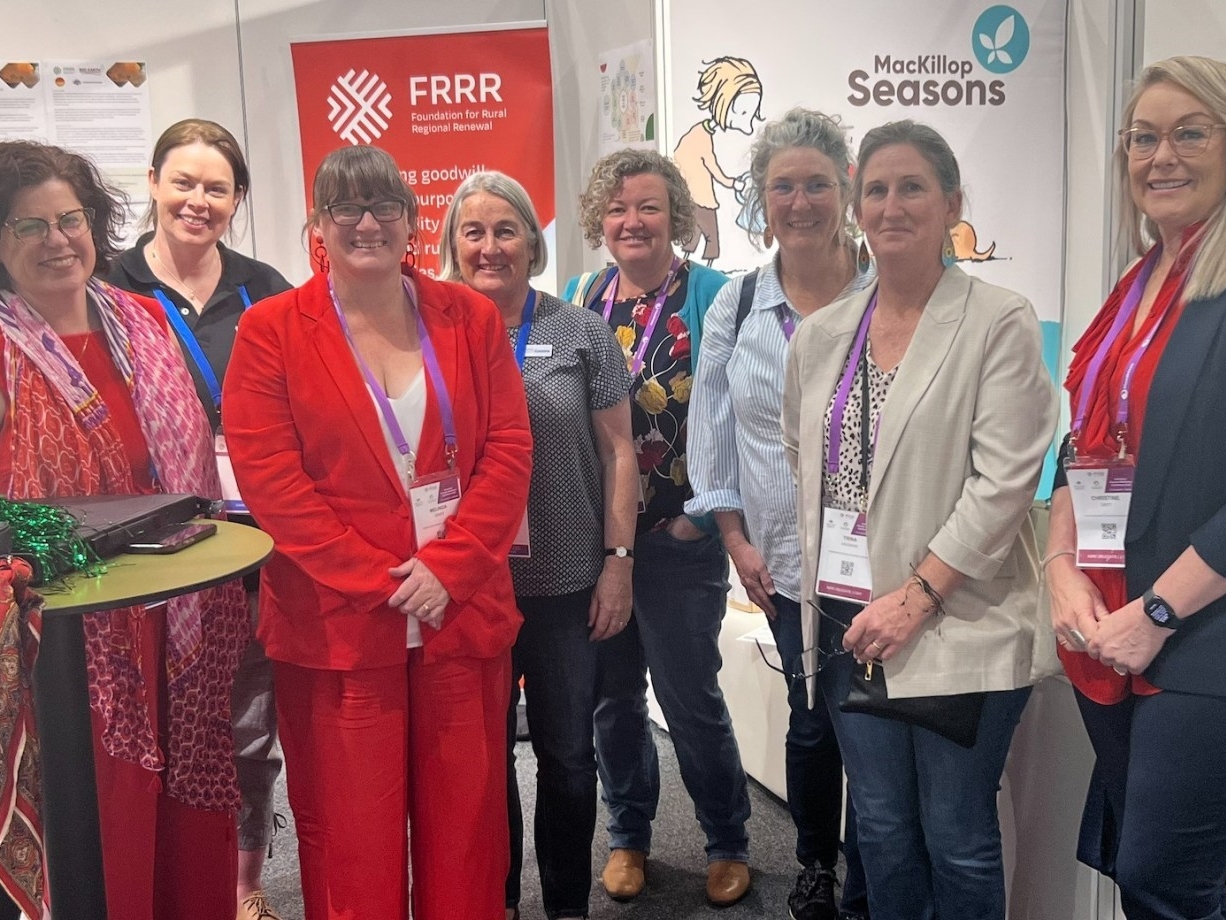
And as a side note from ADRC23; the feedback from communities is clear. They want flexible funding criteria, longer timelines, negotiated measures of success, simpler forms and reporting – and patience from funders. As a mechanism to deliver support to approximately 1000 small projects per year; with around half of those related to disaster impacts; FRRR is working hard to meet these requests with flexible guidelines, negotiated timelines where possible, agile timing, and a streamlined approach to applying and reporting.
Without deliberate, balanced investment in social, cultural, political and human capital, alongside traditional capital, the impacts and harm from disasters will continue to escalate in our communities. We need a systems-based lens that prioritises people and processes to meet future community needs and challenges effectively.
The long-term benefits of this shift are significant; capable local individuals, agile community-based networks, strong not-for-profit organisations and ultimately resilient remote, rural and regional communities become the norm. This paves the way for a future where communities can thrive, adapt and face the uncertainties of a changing climate, with resilience and hope.
Three regional communities to take part in multi-year initiative
FRRR’s Disaster Resilient: Future Ready (DR:FR) Victorian program continues to build steam, with three regional communities selected to partner with the Foundation to strengthen the resilience and preparedness of their regions.
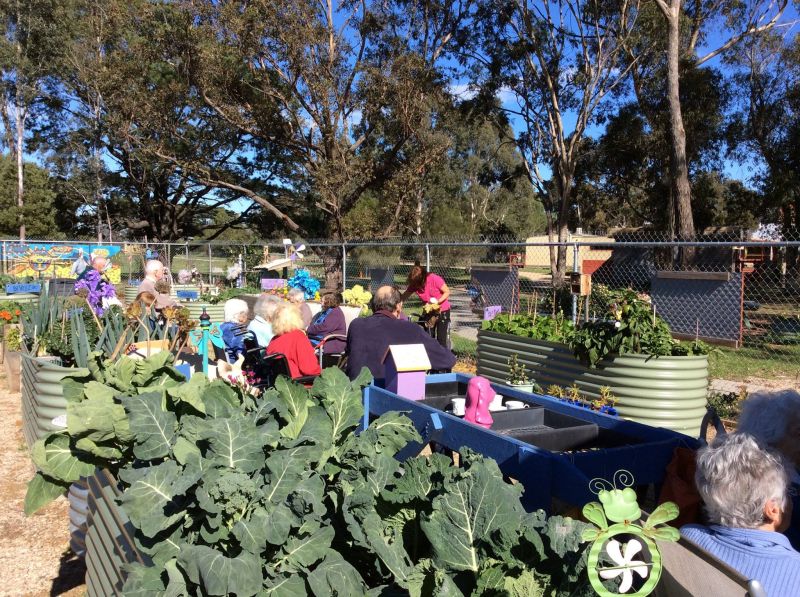
Korumburra, Myrtleford and Whittlesea township and surrounds will receive support as part of a multi-year, community-led program that is supported by a number of philanthropic organisations.
Nina O’Brien, FRRR’s Disaster Resilience and Recovery Lead, said that the DR:FR initiative works to better prepare communities to address the impacts of climate change, natural disasters and broader disruptions that affect the sustainability, vitality and resilience of remote, rural and regional communities across Australia.
“This is a place-based initiative, whereby FRRR works at a hyper-local level with grassroots organisations and community representatives who are interested in collaborating and leading initiatives to increase community preparedness and strengthen resilience capacity.
“The model is designed to help communities identify and then enact solutions that are held in local knowledge and the intersections of people and place. It creates space, facilitates processes, builds relationships and provides resources for community-generated resilience conversations and initiatives to be held at a pace and style that is appropriate for each local community,” Ms O’Brien explained.
Community driven
Late last year community representatives were invited to submit an Expression of Interest (EOI) to become partner communities. Over the past eight months, FRRR’s DR:FR Program coordinator has engaged with representatives from the shortlisted communities, listening and learning about what is unique and important to each place and exploring their readiness, willingness, and capacity to participate in this intensive process.
This process helped FRRR understand their shared aspirations, what they believe is important about their community and demonstrated the commitment and interest in participating in the program.
“The emphasis is on the communities being actively engaged and involved in the process. Our aim is to empower local people to build and adapt the strengths, tools and resources that already exist in each community to further strengthen the resilience and preparedness of each place. It will be community-led and tailored to each community, with support and resources provided to allow them to identify, create and sustain their own resilience-building approaches,” Ms O’Brien said.
The program will start in the next month, beginning with a series of activities to bring interested community members together and start engaging with the broader community around aspirations for the future. In addition to the facilitation support from FRRR, the communities will have access to funding for community activities that support community engagement activities and a seed funding pool to engage a local community connector and activate priority actions identified through the DR:FR journey.
More communities waiting in the wings
“While three communities have been selected, there is strong interest from other places to participate in this program,” Ms O’Brien said.
“We have several communities keen and ready to jump on board and we would love to work with them. Our hope is to expand this program to at least one other Victorian community, and we also have groups in other states wanting to be involved.
“But this requires further funding, so we and our partners can work alongside and support local leaders to create meaningful and lasting change that means they can endure, adapt and evolve from disruptions and disasters more quickly, positively and strongly.
“We are grateful to our current partners for making the Victorian DR:FR program possible. We’d love to hear from others with the capacity to partner with us to expand the program,” Ms O’Brien said.
The DR:FR initiative is kindly supported by the following partners: Sidney Myer Fund, Lord Mayor’s Charitable Foundation, Maple-Brown Family Foundation, Simon Kucher and Partners, Ronald Geoffrey Arnott Foundation, H & L Hecht Trust, Suncorp, Pinnacle Charitable Foundation and the Doc Ross Family Foundation.
For more information about the program, visit https://frrr.org.au/drfr-victoria/.
By Nina O’Brien, Disaster Resilience and Recovery Lead
In recent weeks, with funding being awarded through various FRRR programs, we have started to see concepts lift from the page and move into activated ideas. It also comes at a time when intersecting international conversations of climate urgency relating to COP 26 and the IPCC Report feature heavily in our daily media news feeds. So, it is timely to pause, and reflect on the tapestry of drought preparedness and resilience-building activity being undertaken across Australia, and to share some observations.
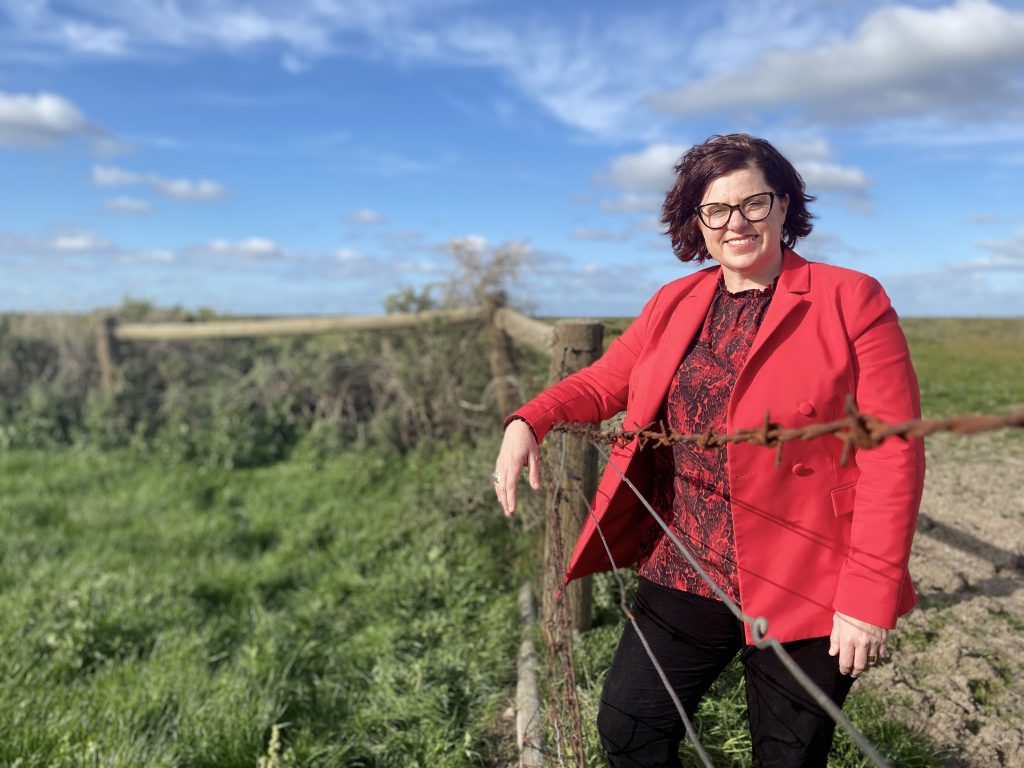
While the future climate challenges are as diverse as the landscapes where they are located; the people and communities of remote, rural and regional Australia are actively engaging in local solutions, decision-making and networking as a means of gaining and sharing the skills and knowledge needed to prepare their community and region for an increasingly drying climate, and sometimes challenge long-held attitudes.
On the national stage, the Rural and Regional Affairs and Transport References Senate Committee recently published its finding into its enquiry on the Federal Government’s response to the drought, and the adequacy and appropriateness of policies and measures to support farmers, regional communities and the Australian economy. In addition, the Australian Government’s Future Drought Fund initiatives are starting to take flight across multiple streams of investment that aim to build an economic, environmental, and socially resilient nation capable of enduring the impact of climate change. At FRRR, part of our challenge is synthesising the international, national, and state contexts with a hyper-local application of understanding and ideas to bring value to local people and places, as we work alongside them to imagine a vibrant future.
It’s our belief that remote, rural, and regional communities have the knowledge to best respond to the impacts of drought, climate change and other natural disasters. So, it has been incredibly heartening to see the diversity of response from communities in building their local networks, capacity, skills, and knowledge to respond to future drought and disaster events.
The first-round of recipients of the Australian Government Future Drought Fund’s Networks to Build Drought Resilience program have elicited a range of interesting patterns across the continent. Among them, and reflective of the increasing part that women are playing in key decision-making roles in rural and regional communities, concepts to build drought resilience locally-devised by women have emerged as a strong theme across multiple states.
A case in point. Although the mean rainfall has been relatively stable across the Eyre Peninsula in the last 30 years, the average days over 38 degrees have increased, and rainfall has decreased in autumn and in the late winter and early spring months, compared to the preceding 30 year period. Against this backdrop, Women Together Learning (WoTL), from Rudall in South Australia, are actively working to building their ambassador network to support women in agriculture through five workshops focusing on future drought, climate projections and the impact on agricultural practices and rural communities. The project involves building the capacity of the WoTL Ambassadors to participate in planning, professional development, and networking.
The project will bring women together, who ordinarily may connect, to form an ongoing future network to build skills, knowledge, and personal connections to be better informed about challenges that the changing climatic patterns presents. With a mean total of 300mm rain per year, planning ahead, and collective problem solving through strong networks will be critical to the region’s success.
On the other side of the country, in a completely different agricultural landscape and climate impact context, is the Northern Rivers Community Gateway Inc who are leading the Women on The Land – Get Ready Empower Yourself Preparedness Workshop Series in Casino, in New South Wales.
This project will deliver five workshops to improve the confidence and reduce social isolation of rural and regional women, while also providing planning and coping tools for the participants to share with their broader networks. Focusing on decision making, preparedness and land management, the workshops will provide a forum to build positive mental health of rural and regional women, while also providing access to service providers and the opportunity to build networks for ongoing cohesion and support.
In another example, the Liebe Group, an active grass-roots grower group from the Dalwallinu region of Western Australia, is also playing an active role in supporting women in drought resilience through their Women In Ag Networking and Diversification (WAND) Program: Strengthening Social Connection and Farm Business Resilience. Importantly, this project will host onsite field visits and an agricultural show day to provide participants with future planning knowledge for below-average seasons and increased business acumen to adapt to the negative effects of drought. Through the project, the local women in agriculture involved in the projects will build capacity and resilience, as well as regional networks to respond to the impacts of drought, both socially and on their farm businesses.
The strength of these projects lies in the hyper-local but interconnected structure of these projects, as affirmed by the recent research commissioned by FRRR that indicates:
‘Resilience is not something that individuals or communities can achieve on their own. It is achieved through the combined and intersecting structures, processes, formal and informal networks and supports in communities working together. What we see as individual or community resilience is part of and supported by a collective effort by agencies, organisations, community groups, business and community members.’
We look forward to continuing to support groups like these, as they identify the most appropriate responses to these ongoing challenges, and equally take advantage of the opportunities that will no doubt emerge, as they strive for a vibrant and sustainable communities.

